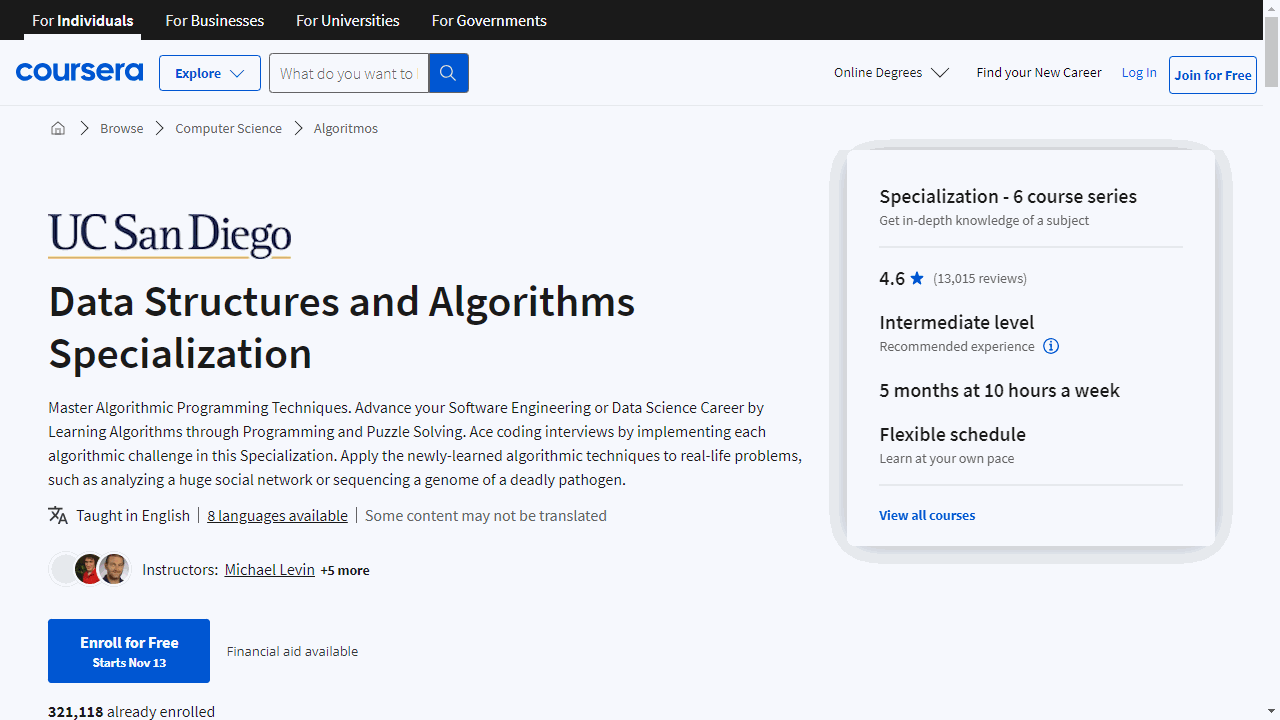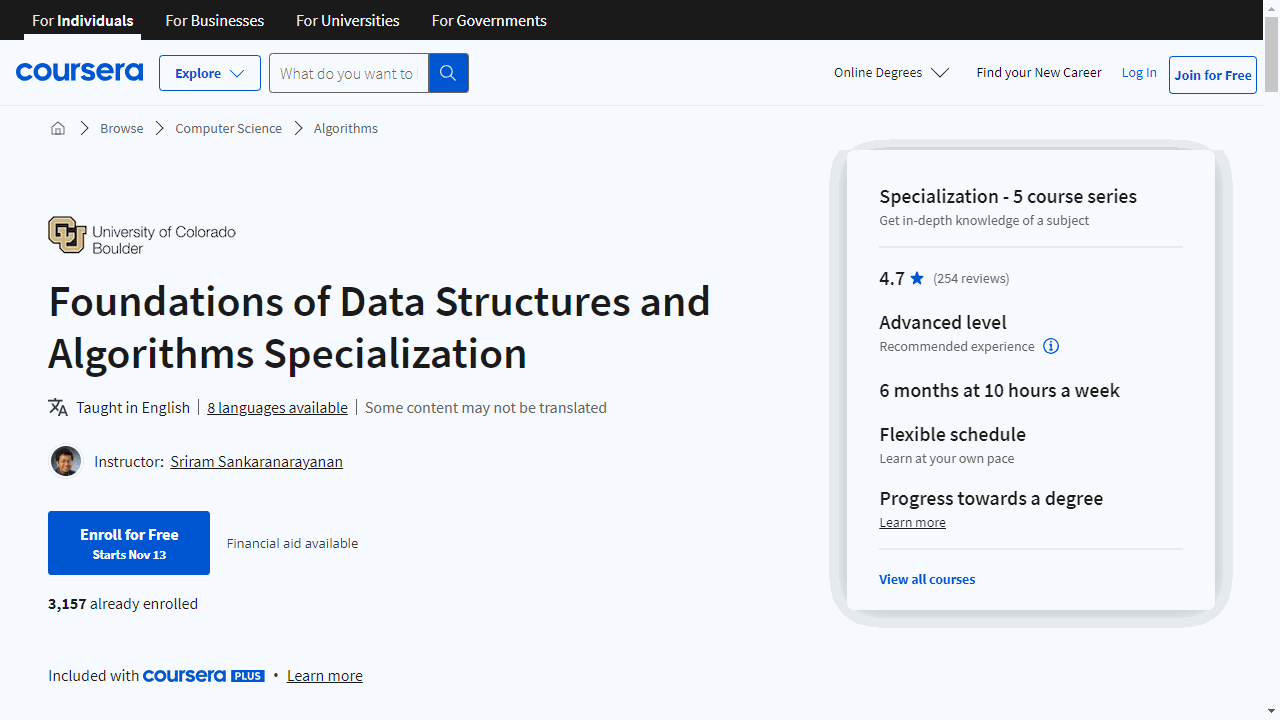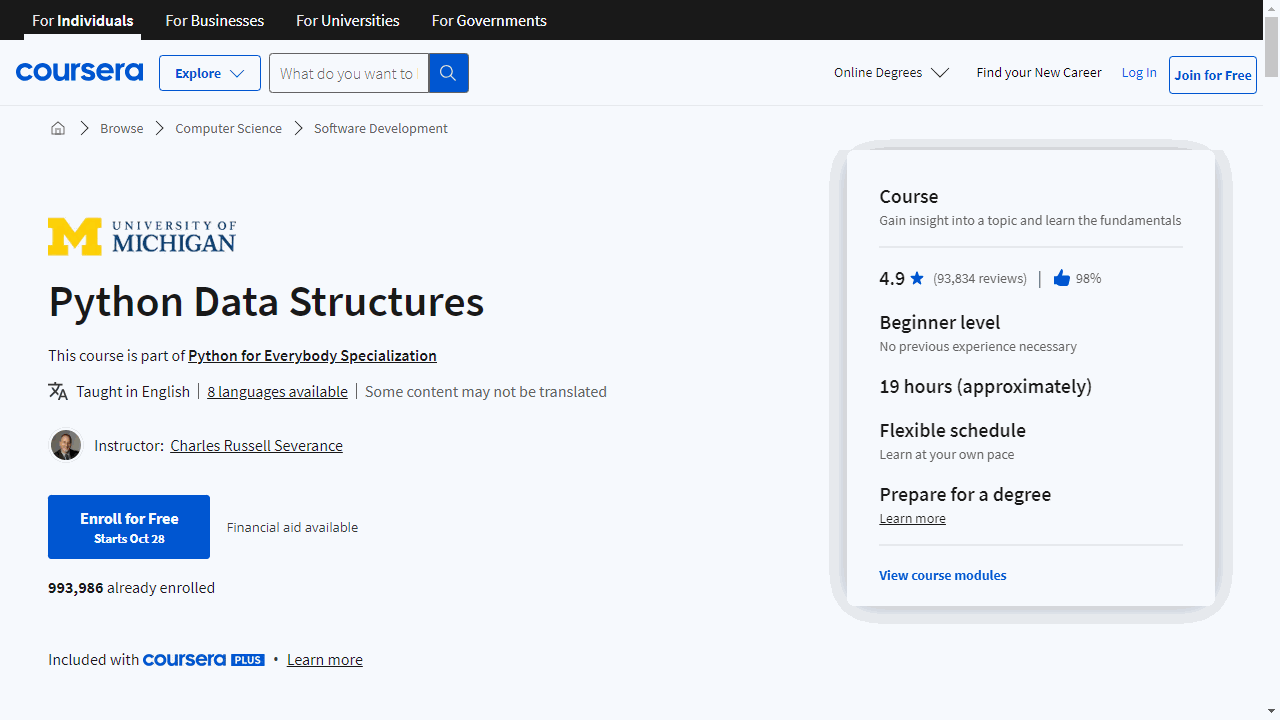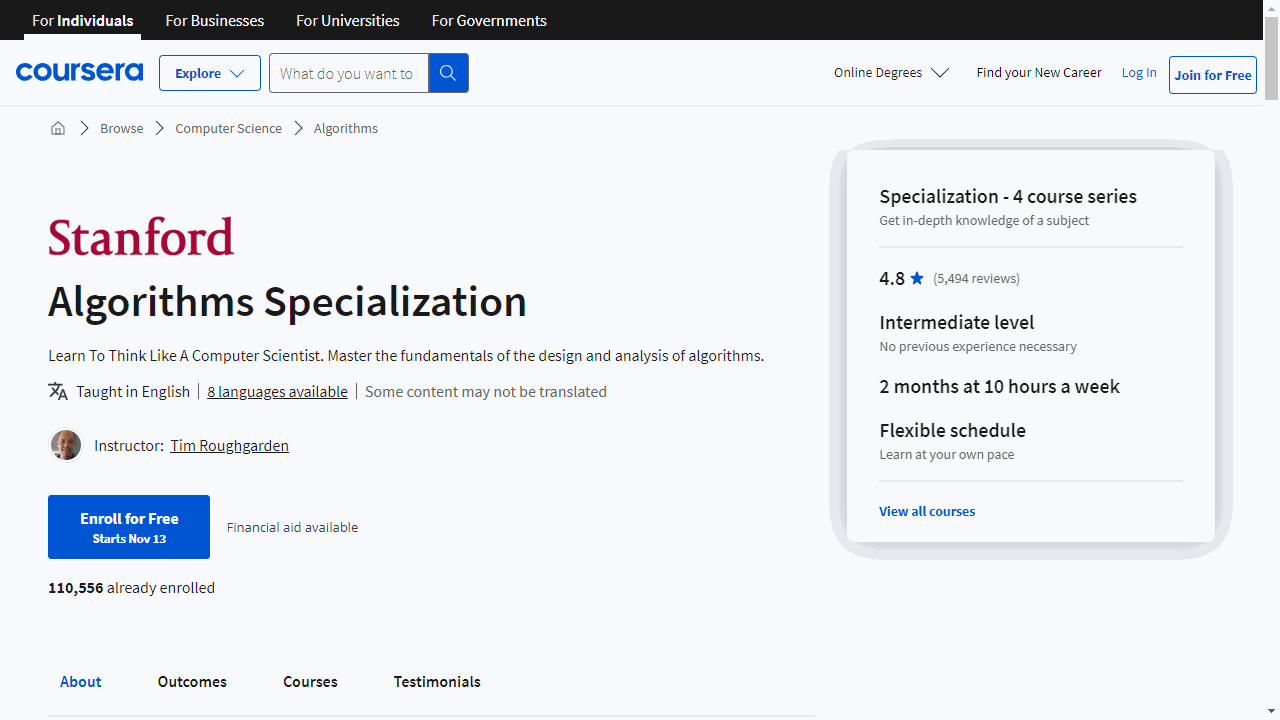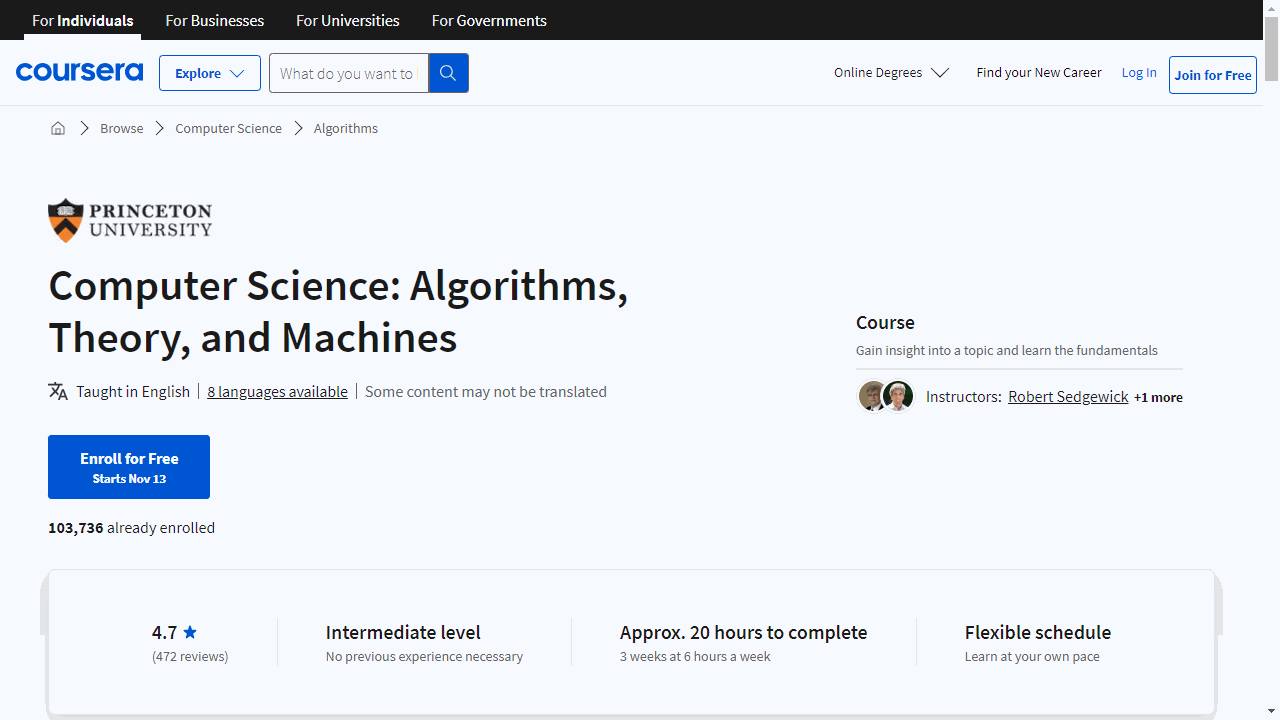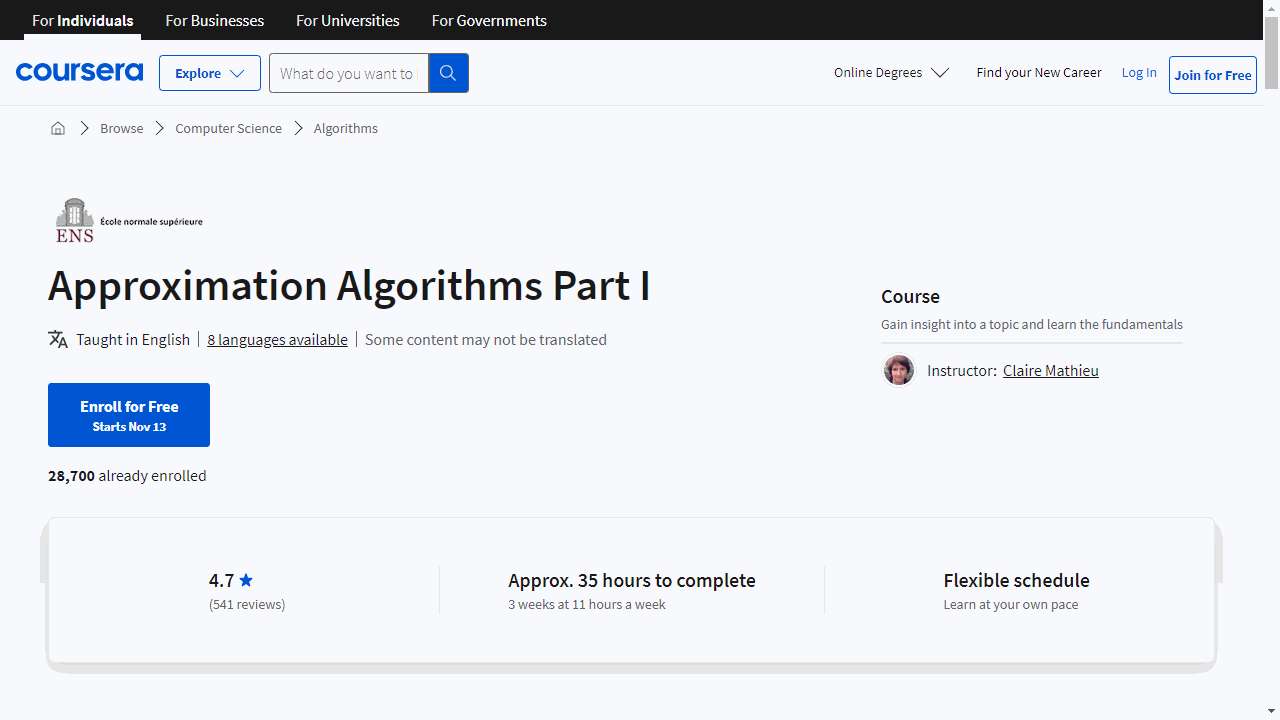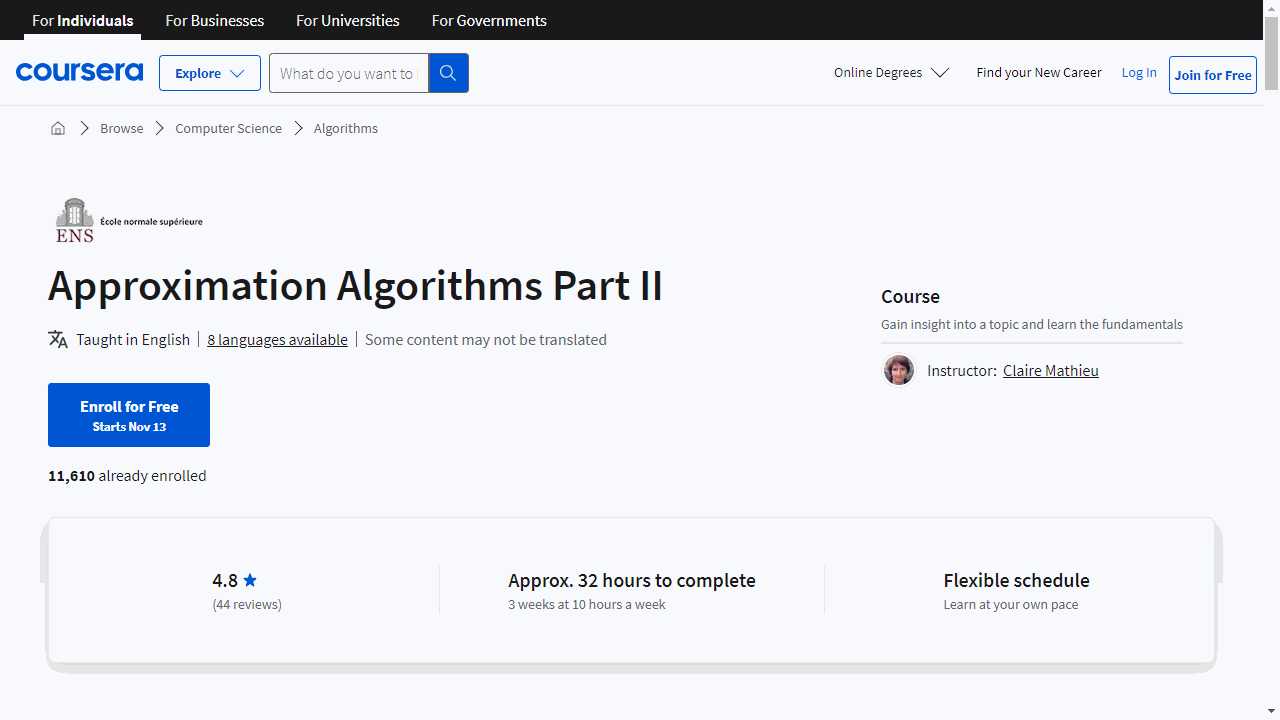Data structures and algorithms (DSA) are the building blocks of efficient and scalable software.
They are essential for any programmer who wants to write code that performs well, handles large amounts of data, and solves complex problems.
By mastering DSA, you can build sophisticated applications, optimize existing code, and gain a competitive edge in the tech industry.
Finding the right data structures and algorithms course on Coursera can be challenging.
You want a program that’s comprehensive, engaging, and taught by experts, but also fits your learning style and goals.
For the best data structures and algorithms course overall on Coursera, we recommend the “Data Structures and Algorithms Specialization” by University of California San Diego.
This specialization provides a comprehensive introduction to the fundamentals of DSA, covering topics such as arrays, linked lists, trees, graphs, sorting, searching, and more.
The course features engaging video lectures, interactive quizzes, and coding challenges, making it an ideal choice for both beginners and those seeking to refresh their knowledge.
While this is our top pick, there are other great options available for learners with different backgrounds and interests.
Keep reading to discover our recommendations for various learning levels, specific topics, and career paths, and find the perfect DSA course for you.
Data Structures and Algorithms Specialization
The “Algorithmic Toolbox” course lays the foundation with essential algorithmic techniques.
You’ll delve into practical applications like sorting and searching, and tackle complex concepts such as greedy algorithms and dynamic programming.
The course is designed to sharpen your problem-solving skills and enable you to implement algorithms that are not only correct but also efficient.
Moving on to the “Data Structures” course, you’ll understand that behind every great algorithm is an even greater data structure.
This course demystifies how data structures work and how they’re implemented across various programming languages.
You’ll gain insights into real-world applications, like how cloud services manage large files, and learn to anticipate the behavior of data structures in your code.
With “Algorithms on Graphs,” you’ll enter the realm of real-world networks.
From road maps to social networks, this course equips you with the tools to navigate and manipulate graph data.
You’ll learn to find the shortest paths and connect networks efficiently, skills that are crucial for anyone working with large-scale systems.
In “Algorithms on Strings,” the focus shifts to textual data.
This course teaches you how to process and search through strings effectively, a fundamental skill in the era of big data.
You’ll explore advanced concepts like suffix trees and arrays, which are the backbone of efficient search algorithms and have applications in genomics.
The “Advanced Algorithms and Complexity” course challenges you to build upon your existing knowledge.
You’ll encounter network flows and linear programming, diving into complex problems and exploring how to approach them when a perfect solution isn’t feasible.
This course also introduces you to streaming algorithms, essential for processing large datasets.
Lastly, the “Genome Assembly Programming Challenge” offers a hands-on experience.
You’ll apply your skills to a real-world problem, assembling the genome of a pathogen from sequencing data.
It’s a unique opportunity to see the direct impact of your work in computational biology.
Foundations of Data Structures and Algorithms Specialization
The course “Algorithms for Searching, Sorting, and Indexing” is a great starting point.
It covers the essentials of algorithm design and analysis, focusing on practical sorting methods and data structures like priority queues.
You’ll also explore real-world applications, such as using hash functions and Bloom filters.
Moving on, “Trees and Graphs: Basics” delves into the fundamental algorithms used in tree and graph data structures.
You’ll learn how to efficiently manage data through binary search trees and understand the intricacies of graph traversal.
The course also touches on advanced topics, including spatial data structures, which are increasingly relevant in today’s data-driven landscape.
For a deeper dive into algorithmic strategies, “Dynamic Programming, Greedy Algorithms” introduces you to powerful techniques such as divide and conquer, dynamic programming, and greedy algorithms.
It also provides a primer on the complexities of intractable problems, offering insight into the challenges of P vs NP.
This course is part of the curriculum for both the MS in Data Science and MS in Computer Science degrees at CU Boulder.
The “Approximation Algorithms and Linear Programming” course is particularly useful for those interested in optimization challenges.
You’ll learn to formulate and solve linear and integer programming problems, which are common in various industries for resource allocation and scheduling.
The course also covers approximation algorithms, providing strategies for finding solutions that are close to optimal.
Lastly, “Advanced Data Structures, RSA and Quantum Algorithms” introduces cutting-edge topics in computer science.
You’ll gain an understanding of number-theory based cryptography and the basics of quantum algorithms.
This course is especially relevant for those interested in the security implications of quantum computing and the future of encryption.
Each course in this specialization offers a blend of theoretical knowledge and practical application, with Python programming woven throughout.
The specialization is structured to provide a clear progression of skills, building up to advanced concepts.
Moreover, the option to earn academic credit towards CU Boulder’s graduate degrees adds significant value for those considering further education.
Object Oriented Java Programming: Data Structures and Beyond Specialization
The journey begins with “Object Oriented Programming in Java,” where you’ll enhance your Java skills by learning the principles of Object Oriented Programming.
This course isn’t just about theory; you’ll apply what you learn by building a project that interests you, using advanced Java features and graphical user interfaces.
As you progress to “Data Structures and Performance,” you’ll delve into the mechanics of handling large data sets efficiently.
By exploring industry-standard data structures like linked lists, trees, and hashtables, you’ll understand how to optimize your programs for speed and flexibility.
The course emphasizes the importance of Big-O analysis, equipping you with the ability to evaluate the performance of your algorithms.
In “Advanced Data Structures in Java,” you’ll tackle real-world problems using complex data structures such as graphs.
The course culminates in a project where you’ll create a route planning application, applying the concepts you’ve learned to a tangible challenge.
This module also focuses on writing maintainable code, an essential skill for any software engineer.
“Mastering the Software Engineering Interview” prepares you for the job market.
This course offers a blend of technical problem-solving practice and communication skills development, with insights from Google’s teams.
You’ll engage in mock interviews and team exercises, building the confidence needed to excel in technical interviews.
The specialization wraps up with the “Capstone: Analyzing (Social) Network Data,” where you’ll apply all the skills you’ve acquired to analyze complex social networks.
This project-based finale gives you the freedom to explore data and draw meaningful conclusions, showcasing your ability to handle real-world data analysis tasks.
Python Data Structures
Covering a broad range of topics, including strings, files, lists, dictionaries, and tuples, the course offers a comprehensive understanding of data structures, a fundamental aspect of any programming language.
One of the standout features of this course is the instructor, Dr. Chuck.
Breaking down complex concepts into clear, digestible information has been highly praised by students. His passion for the subject is not only infectious but also makes learning a more enjoyable experience.
But the learning doesn’t stop at theory.
The course offers practical assignments that allow you to apply the knowledge you’ve gained. Although a few students found these tasks challenging, the majority felt that these exercises boosted their confidence and solidified their programming skills.
A small number of students mentioned difficulties with the assignments and lack of support from the teaching assistant. However, these instances seem to be exceptions rather than the rule.
The overall consensus points to a positive learning experience.
Data Structures and Algorithms Specialization (Chinese)
This specialization is taught in Chinese!
This series of courses is designed to equip you with the necessary tools to tackle complex coding challenges with ease and confidence.
The journey begins with “Data Structures and Algorithms (I),” where you’ll develop a strong understanding of vectors and lists.
This course isn’t just about learning theory; it’s about applying these concepts to real-world problems.
You’ll learn to evaluate and implement basic sorting and searching algorithms, such as Bubblesort and Binary Search, which are essential for optimizing code performance.
As you progress to “Data Structures and Algorithms (II),” the curriculum introduces you to more intricate structures like stacks, queues, and binary trees.
Practical applications are a focus here, with exercises like Huffman encoding and graph traversal techniques including BFS and DFS.
The course also covers AVL trees, a critical structure for maintaining sorted data.
In “Data Structures and Algorithms (III),” the spotlight turns to hashing and balanced binary search trees.
You’ll explore the design and implementation of Hashtables, and delve into the mechanics of trees such as Splay, Red-Black, and B-trees.
These structures are pivotal for efficient data storage and retrieval, and you’ll learn to apply them to scenarios like range queries.
The final course, “Data Structures and Algorithms (IV),” rounds out your education with advanced topics like Priority Queues and string matching techniques.
You’ll understand and implement various sorting algorithms, including Quicksort and Heapsort, and tackle string matching challenges with algorithms like KMP and BM.
This course ensures you’re well-versed in the algorithms that underpin many of today’s search and sort functionalities.
Algorithms Specialization
This is the specialization version of the classic “Design and Analysis of Algorithms” by Tim Roughgarden from Stanford University that used to be two separate courses.
In the first course, “Divide and Conquer, Sorting and Searching, and Randomized Algorithms,” you’ll start learning Big-O notation, which is crucial for gauging algorithm efficiency.
Sorting, searching, and recursion are next, teaching you to organize and retrieve data effectively.
The divide and conquer technique, which simplifies complex problems like matrix multiplication, which is very important in machine learning, as are the randomized algorithms that introduce an element of chance into problem-solving, exemplified by QuickSort.
In “Graph Search, Shortest Paths, and Data Structures,” you’ll delve into the intricacies of graph navigation.
Data structures such as heaps and hash tables are your tools for managing and accessing data swiftly.
You’ll also learn to traverse graphs using search algorithms, essential for tasks like network analysis.
The course emphasizes practical applications, ensuring you can apply these concepts to real-world problems.
The third course, “Greedy Algorithms, Minimum Spanning Trees, and Dynamic Programming,” focuses on optimization.
Greedy algorithms teach you to make locally optimal choices that lead to globally efficient solutions.
You’ll explore minimum spanning trees, which connect points in the most resource-efficient way possible.
Dynamic programming is introduced as a method for solving complex problems by breaking them down into simpler subproblems, a technique useful in various computational scenarios.
Finally, “Shortest Paths Revisited, NP-Complete Problems and What To Do About Them” addresses some of the most challenging areas in computer science.
You’ll revisit shortest path algorithms, refining your ability to find efficient routes through networks.
The course also demystifies NP-complete problems, teaching you how to approach these seemingly intractable issues with heuristics and local search techniques.
If you’re eager to enhance your algorithmic thinking and tackle problems with confidence, this specialization is a very valuable investment in your education and career.
Algorithms, Part I (Princeton University)
This course and its sequel, “Algorithms, Part II,” are based on the classic textbook “Algorithms” and taught by the authors, Robert Sedgewick and Kevin Wayne.
The course begins with an introduction that sets the stage for your learning journey.
You’ll quickly move into dynamic connectivity, exploring Quick Find and Quick Union—key concepts for understanding network connections.
The curriculum doesn’t just present these algorithms; it also delves into optimizations that enhance their efficiency.
As you progress, you’ll delve into the Analysis of Algorithms.
This section is crucial as it teaches you to evaluate algorithm performance using mathematical models and growth classifications.
Understanding this will help you write algorithms that are both fast and memory-efficient.
Data structures are next on the agenda, with a focus on memory management.
You’ll learn about stacks and queues, and how to implement them using arrays.
The course also introduces generics and iterators, providing a deeper understanding of how to handle collections of data.
Sorting is a significant part of the course, covering everything from basic Selection Sort to the more advanced Mergesort and Quicksort.
You’ll learn about sorting complexities, comparators, and stability, which are essential for writing effective sorting algorithms.
APIs and elementary implementations are also covered, giving you the foundational knowledge needed to build robust algorithms.
Binary Heaps and Heapsort are introduced, with optional content on event-driven simulation for those interested in exploring further.
The course thoroughly examines tree data structures, including Binary Search Trees, 2−3 Search Trees, and Red-Black BSTs, with an optional module on B-Trees.
These structures are vital for efficient data storage and retrieval.
Multi-dimensional searching and sorting are addressed through Kd-Trees and interval search trees, which have practical applications in various fields like mapping and gaming.
Hash Tables are explained in detail, teaching you how to manage collisions using separate chaining and linear probing.
This knowledge is key to developing algorithms that can quickly handle large datasets.
The optional section on Symbol Table Applications demonstrates how algorithms can be applied to solve practical problems involving sets, dictionaries, indexing, and sparse vectors.
Algorithms, Part II (Princeton University)
This course is a continuation of “Algorithms, Part I” above, and it’s designed to deepen your understanding of algorithms and their applications.
The course begins with an exploration of graphs, which are fundamental structures used to model relationships in datasets.
You’ll learn how to navigate these structures with depth-first and breadth-first search techniques, essential for tasks like network analysis and solving puzzles.
As you progress, the syllabus introduces you to directed graphs (digraphs) and their specific algorithms, such as topological sort and algorithms for identifying strong components.
These concepts are vital for understanding dependencies, like those in task scheduling or software compilation processes.
When it comes to optimizing paths and connections, the course covers minimum spanning trees (MSTs) and shortest paths.
You’ll get hands-on with Kruskal’s and Prim’s algorithms for MSTs, and Dijkstra’s algorithm for shortest paths.
These are not just theoretical exercises; they have practical implications in areas like transportation and telecommunications.
The course also tackles more complex problems like network flows, teaching you the Ford–Fulkerson algorithm.
This part of the syllabus is particularly relevant for understanding optimization in various networks, a skill that’s highly applicable in fields like operations research and logistics.
String processing is another highlight of the course.
You’ll delve into efficient sorting and searching algorithms, which are the backbone of many database and file management systems.
The course covers a range of techniques, from radix sorts to advanced substring search algorithms like Knuth–Morris–Pratt and Boyer–Moore, equipping you with the knowledge to handle large-scale text data.
Beyond these specific algorithms, the course also addresses broader topics such as regular expressions, data compression, and the principles of algorithm design.
You’ll learn to recognize when a problem is inherently difficult to solve quickly, an important skill for any serious problem-solver.
Throughout the course, Java is used as the medium for implementation, which means you’ll be building practical programming skills alongside your theoretical knowledge.
This hands-on approach ensures that you can apply what you learn directly to real-world scenarios.
Computer Science: Algorithms, Theory, and Machines (Princeton University)
If you’re eager to understand the inner workings of computers and want to build a strong foundation in computer science, this course is a smart choice.
Firstly, you’ll get hands-on with algorithms. These are the step-by-step methods computers use to solve problems.
You’ll start with binary search, a quick way to find information, and move on to sorting techniques like insertion sort and mergesort, which organize data efficiently.
The course also introduces you to the concept of the longest repeated substring, which is a bit like finding hidden patterns in a sea of data.
Plus, you’ll become familiar with APIs, the tools that allow different software programs to communicate seamlessly.
You’ll then explore data structures such as linked lists and binary search trees.
These are the frameworks for storing and organizing data, and you’ll learn not just their theory but also how to implement them.
On the theoretical side, you’ll delve into regular expressions and deterministic finite automata (DFAs), which are the rules that guide how computers interpret patterns.
The course also tackles big ideas like computability and the complexity of problems, discussing concepts like P, NP, and NP-completeness.
But this course isn’t all abstract theory.
You’ll get a practical understanding of how computers work, from the basic data types and instructions to the nitty-gritty of machine language programming.
It’s like learning the alphabet before you write a novel, giving you the foundation to understand and control what a computer does.
Finally, you’ll peek under the hood of computers to learn about their architecture.
You’ll study digital circuits, including the adder circuit, which performs calculations, and the arithmetic/logic unit, the decision-maker of the computer.
You’ll also learn about the components like bits, registers, and memory, which are crucial for a computer’s function and memory storage.
By the end of this course, you’ll have a comprehensive understanding of computer science, from the abstract to the concrete.
Approximation Algorithms Part I
The course begins with a clear definition of approximation algorithms, setting the stage for the more complex concepts to come.
As you progress, the course delves into integer programming, a critical area for understanding how algorithms can be used to solve discrete problems.
You’ll learn about linear programming relaxation, a technique that simplifies complex problems, making them more manageable.
Analysis is a recurring theme in the course, emphasizing the importance of not just knowing how to use algorithms but understanding why they work.
This analytical approach is crucial for fine-tuning and applying algorithms effectively.
You’ll encounter practical strategies like greedy algorithms and dynamic programming.
These are essential tools for solving real-world problems, and the course provides concrete examples to illustrate their use.
Approximation schemes are also covered, teaching you how to develop algorithms that deliver high-quality solutions.
The course introduces the Next Fit algorithm, a strategy for handling items of various sizes, and guides you through the process of analyzing large items.
This section is particularly useful for understanding how to approach problems that involve sorting and organizing data.
Randomized rounding is another highlight of the course.
This technique incorporates probability to find solutions for complex problems, and you’ll explore how to perform cost and coverage analysis to evaluate the effectiveness of your algorithms.
As you approach the end of the course, the lectures on iterated and stopping time algorithms will help you understand more advanced concepts in algorithm design and analysis.
Approximation Algorithms Part II
This course is a continuation of “Approximation Algorithms Part I” above, and it’s a thorough exploration of complex concepts like linear programming duality and primal-dual algorithms, presented in a way that’s accessible and engaging.
The course begins with a practical look at linear programming duality.
You’ll examine examples, delve into its properties, and understand the geometry that shapes this area of study.
This foundational knowledge is crucial for grasping more advanced topics, and it’s presented in a way that ensures you’re not just memorizing, but truly comprehending the material.
As you progress, the weak duality theorem comes into play. Learning to prove this theorem is a valuable skill, and this course guides you through it step by step.
You’ll also learn to manipulate the form of linear programs and explore complementary slackness, which is key to solving optimization problems efficiently.
One of the highlights of this course is the section on primal-dual algorithms.
You’ll apply these to the vertex cover problem, gaining practical experience that’s applicable in various algorithmic challenges.
This isn’t just theoretical knowledge; it’s a skill set that you can carry into your career or academic pursuits.
The course then takes a deep dive into the Steiner tree problem, providing a clear problem definition and introducing you to LP relaxation and its dual.
Through a detailed two-part primal-dual algorithm, you’ll get hands-on experience in analysis and proof construction, sharpening your problem-solving abilities.
But the learning doesn’t stop there. The course also covers service and facility opening costs, offering a comprehensive look at different algorithmic strategies.
You’ll even explore a more efficient algorithm, learning to analyze and improve upon existing methods.
In the final modules, you’ll encounter a 2-approximation challenge, tackle both linear and quadratic programming relaxations, and get a taste of semidefinite programming.
The course wraps up with an insightful look into MaxCut, ensuring that you leave with a well-rounded understanding of approximation algorithms.
Also check our posts on:
